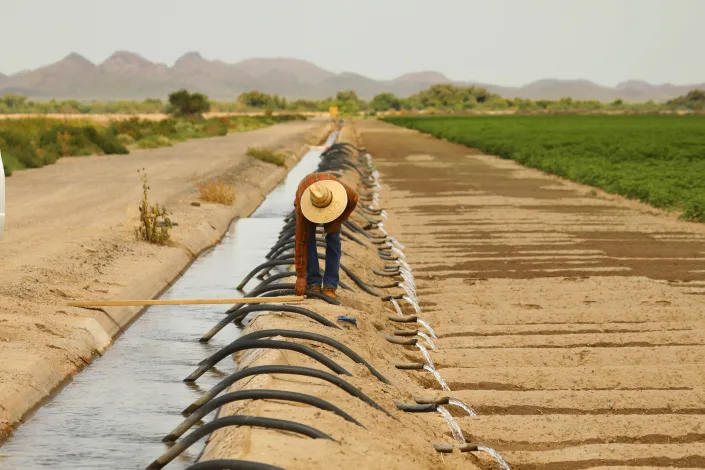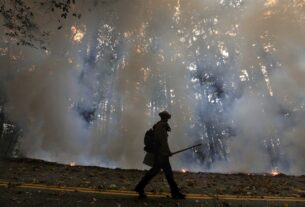Nancy Caywood recalls the days when the white tufts on the cotton plants on her family’s 255-acre farm popped out against the stark blue desert sky, and their alfalfa fields were a sea of green yielding eight to 10 cuttings a year.
“To walk out and smell the fresh hay, there’s nothing like it,” the third-generation Casa Grande, Ariz., farmer told Yahoo News.
This year, thanks to the extreme drought that experts say is exacerbated by climate change, all they’ve been able to grow successfully is weeds.
“My grandfather may have experienced rough times, but never a mega-drought. He’s never had to tear out his entire farm,” said Caywood. “We’re scared to death.”
The water situation is dire in the state of Arizona, which is facing its 22nd year of drought. Despite some relief from the annual monsoons, daily temperatures in the state are still hitting record highs, and local rivers are running dry. In mid-August, the federal government announced its first-ever water shortage declaration for the Colorado River, triggering cuts in the amount of water Arizona will be allowed to draw from it, starting in January.
It’s a reality that scientists say is a result of a warming planet caused by the burning of fossil fuels, and Arizona’s farmers are facing what could be a make-or-break moment for their industry. But while agriculture is well represented in the state’s Republican-majority Legislature, many in the party have refused to acknowledge a link to climate change or pass bills to address it.
“They talk about drought, but don’t talk about the fact that climate change is intensifying the drought. They don’t acknowledge it relative to fires and the fact that fires are larger relative to climate change,” said Sandy Bahr, Grand Canyon chapter director for the Sierra Club. “They are just not in touch with science at all. Or any of the reports that come out that point to climate change as exacerbating many of these issues.”
Arizona was once a national environmental leader. In 2006, then-Gov. Janet Napolitano signed an executive order to create a climate action plan, making it one of the first states to do so. But there’s been a strong reversal since then. In 2010, the next governor, Jan Brewer, signed a law that forbade any state agencies from monitoring greenhouse gas emissions, and it remains on the books today. In 2015, Arizona’s Legislature prohibited cities from requiring any energy benchmarking in commercial structures. And in 2019, it passed a bill that prevents Arizona’s cities and towns from banning any natural gas or other fossil fuel hookups in buildings.
The state’s current governor, Doug Ducey, came close to acknowledging climate change in 2019, nearly four years into his term, saying: “Nobody knows better than the governor of a state like Arizona, that has such an arid climate and has had to make so many plans and sacrifices to have the rich and abundant water resources that we have, that we have to pay attention to our environment.”
Despite its “arid climate,” agriculture is one of Arizona’s biggest industries. Yuma County, near the southern border, is often referred to as the country’s “salad bowl,” due to its output of leafy greens in the winter. But the impact of the drought is likely to hurt farming in an outsized way.
Politicians in the state are considering desperate measures to help aid the industry, including an expensive water-desalination alternative, as well as a proposal to build a cross-state pipeline to drain water from the ever-flooding Mississippi River.
But agriculture is also a top consumer of water, using nearly 74 percent of the water in the state, according to a 2018 University of Arizona economic impact study, and that fact has created tension between municipalities and environmentalists who believe water conservation, not growing crops, should be the state’s main focus.
State Sen. Juan Mendez, a Democrat, said the bills that have so far been considered by the Legislature focus on conserving the “status quo,” instead of on a true solution. That’s because, he believes, the only real solution to Arizona’s problem is to restrict water allocation. Mendez himself has introduced and co-sponsored a number of bills on climate change in the state.
“No one wants to consider the idea of using less water. They want to throw money at a desalination plant. Now they are honestly considering moving water from another state,” Mendez said. “They are just keeping Pinal County farmers happy. There’s not going to be one answer that solves the drought problem or climate change — or all of these environmental disasters.”
Agriculture nets Pinal County $2.4 billion in annual profits, according to Chelsea McGuire, the Arizona Farm Bureau’s government relations director. It’s anticipated to be one of the first regions in Arizona to see its access to Colorado River water cut off, and instead will have to rely on limited groundwater supply and rain. Water shortage is expected to create a $66 million loss in crop sales there, and it’s causing farmers in the area to think deeply about the industry’s future. But there is also no obvious solution to their plight, says McGuire.
“No one is seeing this as temporary. We are seeing a dryer future. … I think everything is going to have to change, from what I’m growing, to how I’m growing it, to where I’m growing it,” she said.
Paul Ollerton grew up farming in Pinal County. His father, uncle and grandfather were also farmers. He said he’s facing a tough decision this year: He doesn’t have enough Colorado River water to grow all of his crops, nor the capacity to pump enough of it from the ground.
“We knew for a long time that this day was probably coming, and we just didn’t know when,” he said.
A partner and owner of Tierra Verde Farms in Casa Grande, Ollerton estimates he’ll have to leave nearly 25 percent of his fields fallow this year due to lack of water.
“Without really sounding negative and a Debby Downer, I don’t see a lot of future — it’s a tough battle here,” he said.
Many farmers’ frustration lies largely with the local municipalities, which get first choice of the water and then allocate the remaining surface water to farmers. But not all farmers lay the larger blame on climate change.
“I think there might be some things related to it, but I’m not saying climate change is the way to address all of these issues,” Ollerton said. “I don’t think it’s totally responsible for what’s happening. I don’t think I buy some of the theories or science. I think it’s just weather patterns. I think we’re just in a dry cycle.”
Caywood finds it equally hard to know where to place blame, though she says many in her town have pointed a finger at farmers.
“People don’t respect where their food is coming from. This growing in the desert has been done for decades, and we have ideal growing conditions,” she said. “Everybody asks if it’s climate change. I believe it’s cyclical. I believe it’s like climate change. … Whatever is happening, it’s happening fast. I thought something like this would happen over 100 years — this is happening over 20.”
Caywood says her family doesn’t expect to make any profits this year, and as that uncertainty plays out, she’s watched the worry lines grow on the face of her 40-year-old son Travis, also a farmer. She’s not sure what her family will ultimately do with their acreage, but many neighbors have already sold their land to a new growing industry in the state: solar.
“I’m losing my toughness over this. I want to be resilient and bounce back from this, but unfortunately, I am becoming an island surrounded by solar panels,” Caywood said.
She said there’s a chance her farm could be the next sale.
“My dad passed away in January. I was on my way to the farm in April. I drove over the canal and there was low water in it, and I just burst into tears, knowing that that was my livelihood drying up,” she said.


